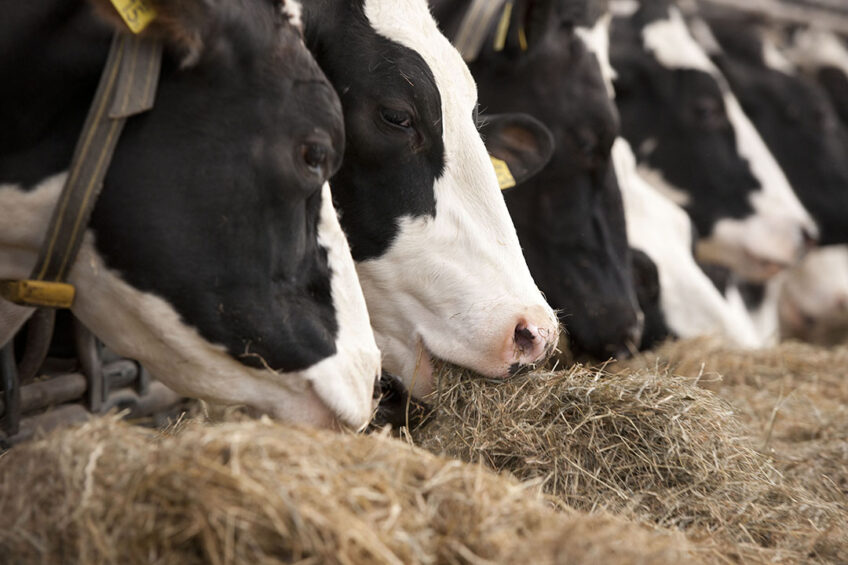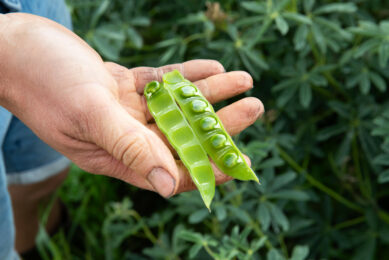How to maximise dairy farm profits in warm countries

Lactating cows are forced to overcome thermal stress while maintaining their high productivity, especially in warmer European countries.
This remains one of the most important financial issues in modern dairy farming as income over feed cost decreases and milk quality characteristics are depressed, minimising herd profitability
To reduce the negative effects of thermal stress, we must understand the biological mechanisms of the cow, while temperatures rise above its comfort zone or thermoneutral zone (higher than 15°C) (Johnson et al., 1980, Griffin et al. 2010). In the thermoneutral zone, the dairy cow has the minimal nutritional requirements to maintain its physiological functions. Heat stress is a symptom of complex biochemical reactions that occur in metabolism when the cow cannot keep its normal body temperature (39°C) constant in response to temperature fluctuations of the warmer farm microenvironment.

The cow continues to run its physiological functions but does so in a different way, which slower than it would normally be. A cow ruminates close to 5 min/kg of feed dry matter (feeding of 110 min/day on a TMR basis). Rumination is well-known to increase body temperature from energy losses due to mechanic energy transformed into heat, while rumen microbes ferment diet nutrients. It is also known that highly productive lactating cows have a healthier rumen and ruminate more efficiently than others. Therefore, cows which ferment their diet more efficiently are more susceptible to heat stress (Purwanto et al. 1990).
Roughages and feedstuffs such as straw, hay and grass tend to increase the ration between acetic to propionic acid in the rumen, thereby eventually increasing the body temperature as more energy is lost during fermentation. Compared with roughages, grains or other concentrates and compound feeds tend to increase propionic acid within the rumen, but propionic acid also creates acidic conditions in rumen microenvironment. This overload can increase the production and absorption of trans-fatty acids, which will then gradually lead to milk fat depression (MFD). Additionally, as pH decreases, histamine production increases, putting cows at risk of laminitis and increased lameness.
 How to keep cow hooves healthy
How to keep cow hooves healthy
Hoof health is important in all stages. A heifer is particularly vulnerable to laminitis around calving and the start of lactation.
Lactating cows and thermal stress
There are several reviews of nutritional management for lactating cows (Beede and Collier, 1986; Huber et al., 1994; Sanchez et al., 1994; West, 1998), but heat stress is unavoidable. Yet, through nutrition and management, we can help minimise its side effects. The cow’s first reaction is to decrease dry matter intake (DMI). DMI depression changes the blood flow to the various tissues, including the mammary glands and the reproductive system. This is the start of a complex disturbance of the cow’s proper nutritional ethological and physiological function, as cows become metabolically inactive as the mobility of their digestive system decreases.
As less fermented feed passes into the intestine, the limited absorption of various nutrients limits milk production even further. As rumination reduces, the cow tries to lower its body temperature by losing heat from its skin but also by increasing its respiratory rate (more than 50 breaths/minute for dairy cows). The increased breathing rate results in continuous CO2 excretion while bicarbonate (HCO3) is eliminated through the urine to regulate blood pH (Benjamin, 1981; West et al., 1991).
 5 things the dairy farmer can do to combat heat stress
5 things the dairy farmer can do to combat heat stress
Now in the summer months, temperatures can tip the scales at well over 30°C in parts Europe. Dairy farmers are being warned of the high risk of heat stress in cattle, with potential for a significant impact on performance and fertility.
A disruption of the anion-cation balance further reduces the vitality of the rumen. All the aforementioned functions increase maintenance requirements from the cow as more energy is needed to run physiological functions outside of the cow’s comfort zone. Cows end up entering a negative energy and nutrient balance while their milk production decreases dramatically, with milk quality also depressed (including a lower fat to protein ratio) (Moore et al., 1992).
Minimising thermal stress
Despite often being neglected, farm management practices and farm design offer many solutions. Several studies show that proper and sufficient shading (Collier et al., 1981, Bond and Kelly, 1955) moderates the stressful effects of heat in cows reared in hot climates. Water should be plentiful and cooler than usual. All animals must have easy access to clean troughs which should not be exposed to direct sunlight. A lactating cow that produces X amount of milk needs almost double this amount in water. Ventilation is also very important. Feed should be available 24/7 and should not be exposed to sun. Sometimes this is compensated by feeding too early in the morning and too late in the afternoon, but even though this practice is common, it is important not to forget that ruminants need time to ruminate their feed properly before their next milking.
 Heat stress affects every stage of the cow cycle
Heat stress affects every stage of the cow cycle
Emerging evidence indicates that heat stress profoundly affects calves and cows from the prenatal stage through lactation.
Nutritionally, we can help the dairy animal adjust its metabolic rate to high temperatures and humid conditions with minor adjustments to the total diet ration. The ratio between forages and concentrates, which can vary according to stage of lactation, is of utmost importance. Given the fact that forages increase body temperature from energy losses of rumen fermentation (West et al. 1999), a slight increase in the concentrates within the total ration is accepted (not higher than 65% of total ration). It is critical for forages to be limited to the minimum amount in order to maintain rumen functionality, and furthermore, it is favourable to turn the usage of moist forages (silages) against dry forages (hays).
Concentrates and compound feeds can be formulated with higher energy density to make up for part of the lost dry matter intake and to maintain milk production, but the more energy density increases, the more feed intake depresses. Also, fatty acids beta-oxidation in the catabolic process results in more water retention. In that case, the supplementary use of energy-increasing nutrients in the form of glucose can help heat stressed lactating cows even if they have already entered a negative energy balance. Protein levels in the complete diet remain a major concern. Apart from the fact that quality proteins are the most expensive nutrients within the diet, decreasing the rate of fast fermented proteins can help reduce body temperature as less microflora activity is required to break down proteins and peptides into amino acids and nitrogen.
 4 top tips to tackle heat stress in dairy cattle
4 top tips to tackle heat stress in dairy cattle
Feeling the stress? There are lots of different forms of stress in dairy production. Pathogenic, environmental, metabolic and transitional challenges are commonplace in dairy herds.
Diets with high RUP (more than 35% of CP) fed during hot weather had no effect on DMI; milk yield, however, increased, and blood urea N declined (Belibasakis et al., 1995). Keeping the balance between fast-slow fermented protein in the rumen (RDP) and protein that escapes rumen degradation (RUP) results in a better amount of metabolizable protein (MP) passing through the gut which will eventually maintain milk production and milk protein levels.
Control of cation-anion balance, vitamins and trace element nutrition
In several periods of the production cycle, but especially during calving under high temperatures and humid conditions, animals need more nutrients as a result of adapting to these environmental circumstances. Regarding mineral nutrition, calcium is a crucial nutrient for dairy cattle. So, where do they get the extra calcium they need for the rapidly increasing lactation requirements while dealing with thermal stress conditions? Most cows adapt to this abrupt demand by mobilising more calcium from bones (PTH hormone in synergy with vitamin D) and reducing its losses through the urinary tract. Cows that do not adapt effectively to this process end up with low blood levels of calcium and cannot cover their needs, moving closer to milk fever. Increased levels of potassium and sodium (cations) in the diet ration (often to maintain water consumption) combined with low levels of chloride and sulphur (anions) limit the cow’s ability to maintain normal blood calcium levels.
 Keep cool and carry on: Combating the effects of heat stress in dairy cows
Keep cool and carry on: Combating the effects of heat stress in dairy cows
Climate change and weather extremes are becoming an increasing issue, not only in the warmer regions but also in more temperate countries.
A cow with a total blood calcium reading below 5.5mg/dl is considered to have hypocalcaemia. During rapid demand in the first phase of lactation, it is enough to calculate that the average cow produces about 8-10 litres of colostrum, containing about 20 – 22 grams of calcium. What is more, heat stressed cows produce colostrum with a lower concentration of IgG (immunoglobulins) (Mochedo Neto et al., 1987, Nardone et al., 1997). A cow with blood calcium of 8 mg/dl or higher at calving is considered to have enough calcium to maintain normal body functions. Limiting dietary calcium intake during close-up while using anionic salts (mainly magnesium sulphate and ammonium chloride) helps the cow to further mobilise more calcium from its bones.
Immediately after calving, the cow can cope better with this sudden change in calcium demand by offering a slight excess of calcium with the ration balanced also on other inorganic salts, especially phosphorus and magnesium. Vitamins levels must be increased slightly because of heat oxidation. Vitamin 3, 1, 12, and E, should be top priority as they hold some key metabolic roles. Furthermore, 7 (biotin) can stimulate the synthesis of glucose in the liver which helps increase energy coming from sugars and thus non-structural carbohydrates. Trace elements like zinc, selenium and copper must be administrated in a more absorbable way to help animals cope with increased enzymatic functions during thermal stress conditions. Betaine, having an osmoregulatory function, can improve ionic exchange within cells and minimise water losses from muscle tissue and gut cells.
 Cow Health special
Cow Health special
Cow health is a key factor in the profitability of a dairy herd. When a cow is struggling with health issues it can lead to a decreased milk yield and lower feed intake.
In conclusion
Dairy farming in warmer countries is often a challenge for farmers and scientists in the sector. If we do not help animals cope with heat stress in multiple ways and with multiple farm practices, we often see significant losses in profits and significant depression in milk quality.
Author: Djionis Savva
Join 13,000+ subscribers
Subscribe to our newsletter to stay updated about all the need-to-know content in the dairy sector, two times a week.










